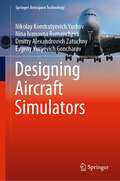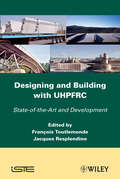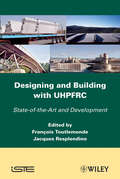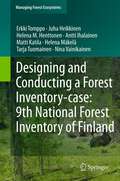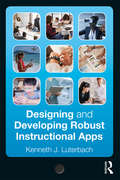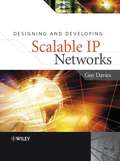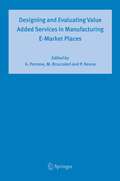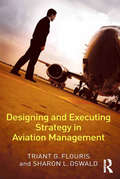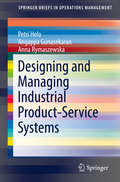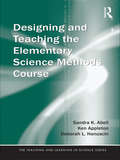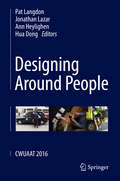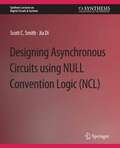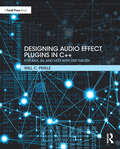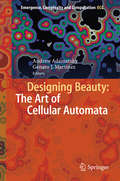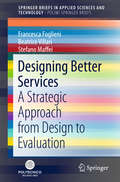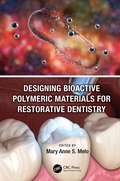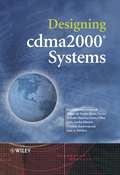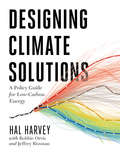- Table View
- List View
Designing Aircraft Simulators (Springer Aerospace Technology)
by Nikolay Kondratyevich Yurkov Nina Ivanovna Romancheva Dmitry Alexandrovich Zatuchny Evgeny Yuryevich GoncharovThis book presents the design of modular architecture flight simulators. Safe transportation of people and goods is one of the main directions for the development of the world economy. At the same time, in conditions of constantly increasing intensity of air traffic, the actions of people, responsible for piloting aircraft and air traffic control are of particular importance. In this regard, special attention should be paid to the process of training such specialists. This book describes various flight simulators of an aircraft, as well as to assess the impact of various characteristics of aviation simulators on the quality of skills of aviation specialists. The book discusses the following issues: 1) method of setting dynamic parameters; 2) methods of correction of simulator parameters, according to expert opinions of operating organizations; 3) modules of simulators of operation of various aircraft units and flight conditions; 4) prospects for the development of aviation simulators; 5) collection and evaluation of information in the process of training on aviation simulators.
Designing and Building with UHPFRC
by Jacques Resplendino François ToulemondeThis book contains the proceedings of the international workshop “Designing and Building with Ultra-High Performance Fibre-Reinforced Concrete (UHPFRC): State of the Art and Development”, organized by AFGC, the French Association for Civil Engineering and French branch of fib, in Marseille (France), November 17-18, 2009. This workshop was focused on the experience of a lot of recent UHPFRC realizations. Through more than 50 papers, this book details the experience of many countries in UHPFRC construction and design, including projects from Japan, Germany, Australia, Austria, USA, Denmark, the Netherlands, Canada… and France. The projects are categorized as novel architectural solutions, new frontiers for bridges, new equipments and structural components, and extending the service life of structures. The last part presents major research results, durability and sustainability aspects, and the updated AFGC Recommendations on UHPFRC.
Designing and Building with UHPFRC
by Jacques Resplendino François ToulemondeThis book contains the proceedings of the international workshop “Designing and Building with Ultra-High Performance Fibre-Reinforced Concrete (UHPFRC): State of the Art and Development”, organized by AFGC, the French Association for Civil Engineering and French branch of fib, in Marseille (France), November 17-18, 2009. This workshop was focused on the experience of a lot of recent UHPFRC realizations. Through more than 50 papers, this book details the experience of many countries in UHPFRC construction and design, including projects from Japan, Germany, Australia, Austria, USA, Denmark, the Netherlands, Canada… and France. The projects are categorized as novel architectural solutions, new frontiers for bridges, new equipments and structural components, and extending the service life of structures. The last part presents major research results, durability and sustainability aspects, and the updated AFGC Recommendations on UHPFRC.
Designing and Conducting a Forest Inventory - case: 9th National Forest Inventory of Finland (Managing Forest Ecosystems #22)
by Erkki Tomppo Juha Heikkinen Helena M. Henttonen Antti Ihalainen Matti Katila Helena Mäkelä Tarja Tuomainen Nina VainikainenThis book demonstrates in detail all phases of the 9th National Forest Inventory of Finland (1996–2003): the planning of the sampling design, measurements, estimation methods and results. The inventory knowledge accumulated during almost one hundred years is consolidated in the book. The purpose of the numerous examples of results is to demonstrate the diversity of the estimates and content of a national forest inventory. The most recent results include the assessment of the indicators describing the biodiversity of forests. The Finnish NFI has been and is a model for many countries worldwide. The methods and results of the book are set in the international context and are applicable globally. The book provides a valuable information source for countries, institutions and researchers planning own inventories as well as modifying the existing ones, or seeking the applicable definitions and estimation methods to use in their own inventories.
Designing and Developing Robust Instructional Apps
by Kenneth J. LuterbachDesigning and Developing Robust Instructional Apps advances the state of instructional app development using three learning paradigms for building knowledge foundations, problem-solving, and experimentation. Drawing on research and development lessons gleaned?from noted educational technologists, time-tested systematic instructional design processes, and results from user experience design, the book considers the planning and specification of instructional apps that blend media (text, images, sound, and moving pictures) and instructional method. Further, for readers with little to no programming experience, introductory treatments of JavaScript and Python, along with data fundamentals and machine learning techniques, offer a guided journey that produces robust instructional apps and?concludes with next steps for advancing the state of instructional app development.
Designing and Developing Robust Instructional Apps
by Kenneth J. LuterbachDesigning and Developing Robust Instructional Apps advances the state of instructional app development using three learning paradigms for building knowledge foundations, problem-solving, and experimentation. Drawing on research and development lessons gleaned?from noted educational technologists, time-tested systematic instructional design processes, and results from user experience design, the book considers the planning and specification of instructional apps that blend media (text, images, sound, and moving pictures) and instructional method. Further, for readers with little to no programming experience, introductory treatments of JavaScript and Python, along with data fundamentals and machine learning techniques, offer a guided journey that produces robust instructional apps and?concludes with next steps for advancing the state of instructional app development.
Designing and Developing Scalable IP Networks
by Guy DaviesDesigning and Developing Scalable IP Networks takes a “real world” approach to the issues that it covers. The discussions within this book are rooted in actual designs and real development, not theory or pure engineering papers. It recognises and demonstrates the importance of taking a multi-vendor approach, as existing network infrastructure is rarely homogenous and its focus is upon developing existing IP networks rather than creating them from scratch. This global book based on the author’s many years’ experience of designing real scalable systems, is an essential reference tool that demonstrates how to build a scalable network, what pitfalls to avoid and what mechanisms are the most successful in real life for engineers building and operating IP networks. It will be ideal for network designers and architects, network engineers and managers as well as project managers and will be of particular relevance to those studying for both JNCIE and CCIE exams.
Designing and Evaluating Value Added Services in Manufacturing E-Market Places
by Giovanni Perrone Manfredi Bruccoleri Paolo RennaThe “extended enterprise” is a new emerging paradigm in the manufacturing arena. Indeed, global competition is pushing manufacturing enterprises in several industries either to split geographically the production capacity or to work together in supply chain organizations involving several independent entities. This dynamic is involving both big companies, whose organisation is always more and more decentralised and geographically distributed, and Small and Medium Enterprises (SMEs) that are embracing new organisation forms such as the Virtual Enterprise (VE) one. The “extended enterprise” allows gaining agility, reactive ness, even p- activeness, and, of course, efficiency in the highly dynamic markets of the mass customisation and knowledge based economy era. However, the “extended enterprise” paradigm scales management complexity both at the strategic and operational level up. This requires new tools for managing the complexity of the extended enterprise. The Information and Communication Technology (ICT) enables the possibility to create new and innovative “tools for managing the extended enterprise”. This book addresses the above introduced issue of the tools for the extended enterprise. More specifically, it presents the results of a research developed under a two years program titled “ “Distributed process and production planning in manufacturing enterprise networks” and funded by the Italian Ministry of Education, University and Research (MIUR) under the program PRIN2001.
Designing and Executing Strategy in Aviation Management
by Triant G. Flouris Sharon L. OswaldDesigning and Executing Strategy in Aviation Management is designed to provide an intensely practical guide to this critically important topic. Comprehensive in coverage and easy-to-read in style, it allows both professionals and students to understand the principles and practicalities of crafting and executing business strategies with an aviation context. The result is a comprehensive and multifaceted teaching/learning package, which includes applied case studies on a wide range of airlines and aviation businesses, setting out how these organizations deal with strategy formulation and implementation in critical areas. Topics covered include: corporate strategy, generic strategy, competitive strategy, internal and external environment assessment, mergers, alliances, safety and security. Written directly for both aviation professionals and student courses in aviation strategy, aviation management and aviation operations, it will also be of great interest to aviation professionals in a variety of different fields, including airlines, corporate aviation, consultancy, etc., as well as academics within the field of aviation and those within the field of strategy and management science.
Designing and Executing Strategy in Aviation Management
by Triant G. Flouris Sharon L. OswaldDesigning and Executing Strategy in Aviation Management is designed to provide an intensely practical guide to this critically important topic. Comprehensive in coverage and easy-to-read in style, it allows both professionals and students to understand the principles and practicalities of crafting and executing business strategies with an aviation context. The result is a comprehensive and multifaceted teaching/learning package, which includes applied case studies on a wide range of airlines and aviation businesses, setting out how these organizations deal with strategy formulation and implementation in critical areas. Topics covered include: corporate strategy, generic strategy, competitive strategy, internal and external environment assessment, mergers, alliances, safety and security. Written directly for both aviation professionals and student courses in aviation strategy, aviation management and aviation operations, it will also be of great interest to aviation professionals in a variety of different fields, including airlines, corporate aviation, consultancy, etc., as well as academics within the field of aviation and those within the field of strategy and management science.
Designing and Managing Industrial Product-Service Systems (SpringerBriefs in Operations Management)
by Petri Helo Angappa Gunasekaran Anna RymaszewskaThis book is dedicated to the issues and complexities of industrial services supply chain management. It analyzes how the transition from products to services can be managed, and how supply chains can be adjusted to reflect this new status quo. The book begins with chapters examining product-service systems structures and servitization – the services infusion process. Next, it presents industrial services as marketing and operations strategy. The focus shifts to service delivery, and this chapter discusses how the actual operations take place. This is followed by an examination of the role of technology and how connected assets are utilized by product vendors in value-creation. The book analyzes the transition from ownership to subscriptions in the pricing decisions chapter. Then the value chain effects chapter offers an overview of the mechanisms through which industrial companies are shortening the distance to end-users and aim for a better position in the value chain. Finally the conclusion addresses theoretical and empirical implications in the industrial services supply chain management.
Designing and Teaching the Elementary Science Methods Course (Teaching and Learning in Science Series)
by Sandra K. Abell Ken Appleton Deborah L. HanuscinWhat do aspiring and practicing elementary science teacher education faculty need to know as they plan and carry out instruction for future elementary science teachers? This scholarly and practical guide for science teacher educators outlines the theory, principles, and strategies needed, and provides classroom examples anchored to those principles. The theoretical and empirical foundations are supported by scholarship in the field, and the practical examples are derived from activities, lessons, and units field-tested in the authors’ elementary science methods courses. Designing and Teaching the Elementary Science Methods Course is grounded in the theoretical framework of pedagogical content knowledge (PCK), which describes how teachers transform subject matter knowledge into viable instruction in their discipline. Chapters on science methods students as learners, the science methods course curriculum, instructional strategies, methods course assessment, and the field experience help readers develop their PCK for teaching prospective elementary science teachers. "Activities that Work" and "Tools for Teaching the Methods Course" provide useful examples for putting this knowledge into action in the elementary science methods course.
Designing and Teaching the Elementary Science Methods Course (Teaching and Learning in Science Series)
by Sandra K. Abell Ken Appleton Deborah L. HanuscinWhat do aspiring and practicing elementary science teacher education faculty need to know as they plan and carry out instruction for future elementary science teachers? This scholarly and practical guide for science teacher educators outlines the theory, principles, and strategies needed, and provides classroom examples anchored to those principles. The theoretical and empirical foundations are supported by scholarship in the field, and the practical examples are derived from activities, lessons, and units field-tested in the authors’ elementary science methods courses. Designing and Teaching the Elementary Science Methods Course is grounded in the theoretical framework of pedagogical content knowledge (PCK), which describes how teachers transform subject matter knowledge into viable instruction in their discipline. Chapters on science methods students as learners, the science methods course curriculum, instructional strategies, methods course assessment, and the field experience help readers develop their PCK for teaching prospective elementary science teachers. "Activities that Work" and "Tools for Teaching the Methods Course" provide useful examples for putting this knowledge into action in the elementary science methods course.
Designing Around People: CWUAAT 2016
by Pat Langdon Jonathan Lazar Ann Heylighen Hua DongThis book presents the proceedings of the 8th Cambridge Workshop on Universal Access and Assistive Technology (CWUAAT '16), incorporating the 11th Cambridge Workshop on Rehabilitation Robotics, held in Cambridge, England in March 2016. It presents novel and state-of-the-art research from an international group of leaders in the fields of universal access and assistive technology. It explores various issues including the reconciliation of usability, accessibility and inclusive design, the design of inclusive assistive and rehabilitation systems, measuring product demand and human capabilities, data mining and visualizing inclusion, legislation in inclusive design, and situational inclusive interfaces (automotive and aerospace). This book provides an invaluable resource to researchers, postgraduates, design practitioners, therapists and clinical practitioners, as well as design teachers.
Designing Asynchronous Circuits using NULL Convention Logic (Synthesis Lectures on Digital Circuits & Systems)
by Scott Smith Jia DiDesigning Asynchronous Circuits using NULL Convention Logic (NCL) begins with an introduction to asynchronous (clockless) logic in general, and then focuses on delay-insensitive asynchronous logic design using the NCL paradigm. The book details design of input-complete and observable dual-rail and quad-rail combinational circuits, and then discusses implementation of sequential circuits, which require datapath feedback. Next, throughput optimization techniques are presented, including pipelining, embedding registration, early completion, and NULL cycle reduction. Subsequently, low-power design techniques, such as wavefront steering and Multi-Threshold CMOS (MTCMOS) for NCL, are discussed. The book culminates with a comprehensive design example of an optimized Greatest Common Divisor circuit. Readers should have prior knowledge of basic logic design concepts, such as Boolean algebra and Karnaugh maps. After studying this book, readers should have a good understanding of the differences between asynchronous and synchronous circuits, and should be able to design arbitrary NCL circuits, optimized for area, throughput, and power. Table of Contents: Introduction to Asynchronous Logic / Overview of NULL Convention Logic (NCL) / Combinational NCL Circuit Design / Sequential NCL Circuit Design / NCL Throughput Optimization / Low-Power NCL Design / Comprehensive NCL Design Example
Designing Audio Effect Plugins in C++: For AAX, AU, and VST3 with DSP Theory
by Will C. PirkleDesigning Audio Effect Plugins in C++ presents everything you need to know about digital signal processing in an accessible way. Not just another theory-heavy digital signal processing book, nor another dull build-a-generic-database programming book, this book includes fully worked, downloadable code for dozens of professional audio effect plugins and practically presented algorithms. Sections include the basics of audio signal processing, the anatomy of a plugin, AAX, AU and VST3 programming guides; implementation details; and actual projects and code. More than 50 fully coded C++ audio signal-processing objects are included. Start with an intuitive and practical introduction to the digital signal processing (DSP) theory behind audio plug-ins, and quickly move on to plugin implementation, gain knowledge of algorithms on classical, virtual analog, and wave digital filters, delay, reverb, modulated effects, dynamics processing, pitch shifting, nonlinear processing, sample rate conversion and more. You will then be ready to design and implement your own unique plugins on any platform and within almost any host program. This new edition is fully updated and improved and presents a plugin core that allows readers to move freely between application programming interfaces and platforms. Readers are expected to have some knowledge of C++ and high school math.
Designing Audio Effect Plugins in C++: For AAX, AU, and VST3 with DSP Theory
by Will C. PirkleDesigning Audio Effect Plugins in C++ presents everything you need to know about digital signal processing in an accessible way. Not just another theory-heavy digital signal processing book, nor another dull build-a-generic-database programming book, this book includes fully worked, downloadable code for dozens of professional audio effect plugins and practically presented algorithms. Sections include the basics of audio signal processing, the anatomy of a plugin, AAX, AU and VST3 programming guides; implementation details; and actual projects and code. More than 50 fully coded C++ audio signal-processing objects are included. Start with an intuitive and practical introduction to the digital signal processing (DSP) theory behind audio plug-ins, and quickly move on to plugin implementation, gain knowledge of algorithms on classical, virtual analog, and wave digital filters, delay, reverb, modulated effects, dynamics processing, pitch shifting, nonlinear processing, sample rate conversion and more. You will then be ready to design and implement your own unique plugins on any platform and within almost any host program. This new edition is fully updated and improved and presents a plugin core that allows readers to move freely between application programming interfaces and platforms. Readers are expected to have some knowledge of C++ and high school math.
Designing Beauty: The Art of Cellular Automata (Emergence, Complexity and Computation #20)
by Andrew Adamatzky Genaro J. MartínezThis fascinating, colourful book offers in-depth insights and first-hand working experiences in the production of art works, using simple computational models with rich morphological behaviour, at the edge of mathematics, computer science, physics and biology. It organically combines ground breaking scientific discoveries in the theory of computation and complex systems with artistic representations of the research results. In this appealing book mathematicians, computer scientists, physicists, and engineers brought together marvelous and esoteric patterns generated by cellular automata, which are arrays of simple machines with complex behavior. Configurations produced by cellular automata uncover mechanics of dynamic patterns formation, their propagation and interaction in natural systems: heart pacemaker, bacterial membrane proteins, chemical rectors, water permeation in soil, compressed gas, cell division, population dynamics, reaction-diffusion media and self-organisation. The book inspires artists to take on cellular automata as a tool of creativity and it persuades scientists to convert their research results into the works of art. The book is lavishly illustrated with visually attractive examples, presented in a lively and easily accessible manner.
Designing Better Services: A Strategic Approach from Design to Evaluation (SpringerBriefs in Applied Sciences and Technology)
by Francesca Foglieni Beatrice Villari Stefano MaffeiThis book provides accessible, comprehensive guidance on service design and enables practitioners approaching the discipline for the first time to develop the strategic mindset needed to exploit its innovation potential. The opening chapters trace the origins of service design and examine its links with service innovation, as well as its strategic role in service organizations. It then offers step-by-step guidance on tackling a service design project, explaining the main design elements and indications of various useful design tools. It also introduces the topic of evaluation as a support practice in designing or redesigning better services, and providing evidence concerning the value of service design interventions. The third chapter explores how evaluation is currently approached in service design practice through the analysis of a number of case studies. Based on these experiences it extensively discusses evaluation, with a particular focus on service evaluation, and explains its importance in supporting service design and fostering innovation throughout the service design process. Further it describes pragmatic directions for setting up and conducting a service evaluation strategy. The concluding chapter uses an interpretive model to summarize the role evaluation could have in service design practice and focuses on interdisciplinary competences that need to be acquired by service designers in order to address the evolution of the discipline. The novel approach adopted in the book fosters the growing interest in design-driven service innovation and assists in realizing its full potential in both the private and the public sector.
Designing Bioactive Polymeric Materials For Restorative Dentistry
by Mary Anne S. MeloRestorative biomaterials in dentistry are designed to restore the shape and function of teeth. Their applicability is related to restorative procedures such as dental restorations, dentures, dental implants, and endodontic materials. Designing Bioactive Polymeric Materials for Restorative Dentistry reviews the current state of the art for restorative biomaterials and discusses the near-future trends in this field. The book examines the biomaterials utilized in restorative dental applications (bonding, composites, cements, and ceramics) and assesses the design for these materials and the role of nanotechnology. All of the contributors are active clinical dentists and researchers in this field. FEATURES Overviews the major ongoing research efforts on developing bioactive bonding systems and composites in dental biomaterials Focuses on emerging trends in restorative dental biomaterials Incorporates evidence-based data on new restorative dental materials throughout the book Features extensive references at the end of each chapter to enhance further study Mary Anne S. Melo, DDS, MSc, PhD FADM, is an Associate Professor and Division Director of Operative Dentistry at the School of Dentistry, University of Maryland, Baltimore, Maryland.
Designing Bioactive Polymeric Materials For Restorative Dentistry
by Mary Anne Sampaio De MeloRestorative biomaterials in dentistry are designed to restore the shape and function of teeth. Their applicability is related to restorative procedures such as dental restorations, dentures, dental implants, and endodontic materials. Designing Bioactive Polymeric Materials for Restorative Dentistry reviews the current state of the art for restorative biomaterials and discusses the near-future trends in this field. The book examines the biomaterials utilized in restorative dental applications (bonding, composites, cements, and ceramics) and assesses the design for these materials and the role of nanotechnology. All of the contributors are active clinical dentists and researchers in this field. FEATURES Overviews the major ongoing research efforts on developing bioactive bonding systems and composites in dental biomaterials Focuses on emerging trends in restorative dental biomaterials Incorporates evidence-based data on new restorative dental materials throughout the book Features extensive references at the end of each chapter to enhance further study Mary Anne S. Melo, DDS, MSc, PhD FADM, is an Associate Professor and Division Director of Operative Dentistry at the School of Dentistry, University of Maryland, Baltimore, Maryland.
Designing cdma2000 Systems
by Leonhard Korowajczuk Bruno de XavierCDMA is the second most widely deployed technology in the world with more than 100 million subscribers worldwide and is projected to reach 280 million subscribers by 2006. CDMA 2000 1x was deployed in year 2000 and CDMA 2000 1xEVDO is being deployed this year. CDMA 2000 is the natural migration for CDMA IS-95 networks and some of the TDMA networks. CDMA technology is complex to design due to its inherent adaptive characteristic and the introduction of data requires a complete new way of analysing the network from traffic characteristics to performance requirements. The authors bring a wealth of experience in developing solutions for wireless design at CelPlan Technologies, Inc. since 1992. They followed up the evolution of the wireless technology providing innovative solutions at each step. In this book they summarize the description of the CDMA 2000 technology, revisit basic design concepts and propose new solutions to design and optimise these complex networks. Many of the design issues covered in this book apply also to the novel WCDMA networks that are proposed as the evolution of GSM networks. Designing CDMA 2000 Systems: Describes in detail the structure of CDMA 2000 systems and provides guidelines for their design and optimisation Fills a major gap in the information available today serving as a comprehensive reference for designers and operators Provides coverage from introductory to specialist level Designing CDMA 2000 Systems is highly relevant for engineers involved in the design or operation of CDMA systems, as well as providing a broad understanding of the area for researchers, professors and students in the field
Designing Climate Solutions: A Policy Guide for Low-Carbon Energy
by Hal Harvey Robbie Orvis Jeffrey RissmanWith the effects of climate change already upon us, the need to cut global greenhouse gas emissions is nothing less than urgent. It’s a daunting challenge, but the technologies and strategies to meet it exist today. A small set of energy policies, designed and implemented well, can put us on the path to a low carbon future. Energy systems are large and complex, so energy policy must be focused and cost-effective. One-size-fits-all approaches simply won’t get the job done. Policymakers need a clear, comprehensive resource that outlines the energy policies that will have the biggest impact on our climate future, and describes how to design these policies well.Designing Climate Solutions: A Policy Guide for Low-Carbon Energy is the first such guide, bringing together the latest research and analysis around low carbon energy solutions. Written by Hal Harvey, CEO of the policy firm Energy Innovation, with Robbie Orvis and Jeffrey Rissman of Energy Innovation, Designing Climate Solutions is an accessible resource on lowering carbon emissions for policymakers, activists, philanthropists, and others in the climate and energy community. In Part I, the authors deliver a roadmap for understanding which countries, sectors, and sources produce the greatest amount of greenhouse gas emissions, and give readers the tools to select and design efficient policies for each of these sectors. In Part II, they break down each type of policy, from renewable portfolio standards to carbon pricing, offering key design principles and case studies where each policy has been implemented successfully.We don’t need to wait for new technologies or strategies to create a low carbon future—and we can’t afford to. Designing Climate Solutions gives professionals the tools they need to select, design, and implement the policies that can put us on the path to a livable climate future.
Designing Competitive Electricity Markets (International Series in Operations Research & Management Science #13)
by Hillard G. Huntington Hung-Po ChaoDesigning Complex Products with Systems Engineering Processes and Techniques
by Vivek D. BhiseThis book looks at how to design complex products that have many components with intricate relationships and requirements. It also discusses how to manage processes involved in their lifecycle, from concept generation to disposal, with the objectives of increasing customer satisfaction, quality, safety, and usability and meeting program timings and
